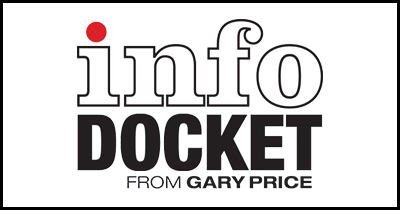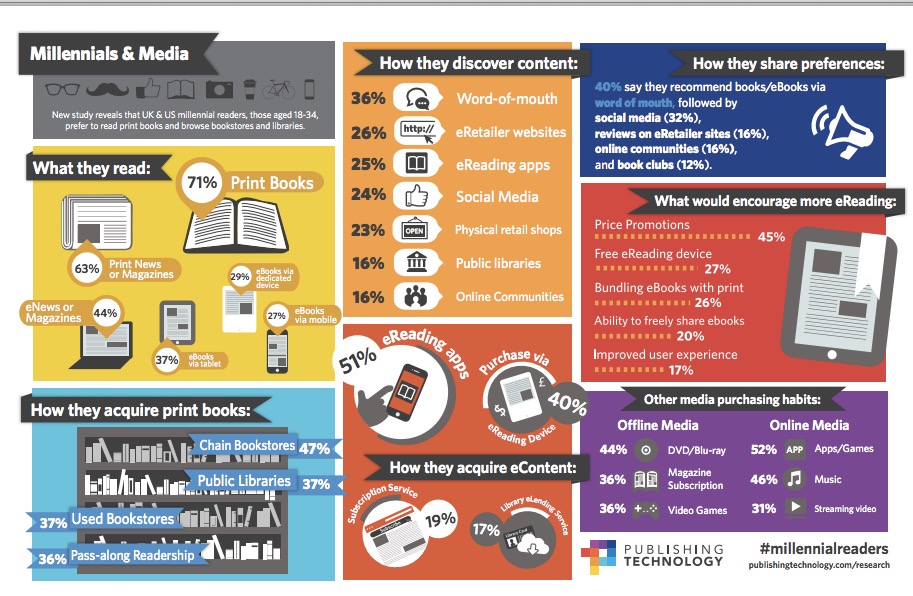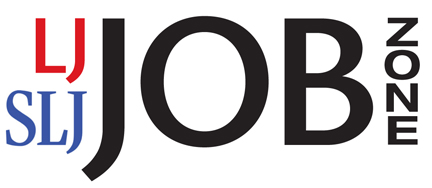Survey Findings: Young Americans Prefer Print Books Over E-Books
Here are key findings from a new study published today by Publishing Technology, a provider of content systems, content delivery, and audience development. Publishing Technology is also the owner of IngentaConnect.
Make sure to note the mention of public libraries as a place to browse and a source to access books.
The survey, which polled 1,000 consumers across the U.S., aged between 18 and 34, found that in the last year, nearly twice as many respondents had read a print book (79 percent), than an ebook on any device – the closest being a tablet (46 percent). Showing no strong allegiance, young Americans also reported reading ebooks on personal computers (37 percent), mobile phones (36 percent) and dedicated ereaders (31 percent).
Where to Purchase and Acquire
The personal touch is still of vital importance for millennials who would rather acquire printed books from chain bookstores (52 percent), used bookstores (45 percent) and [our emphasis] public libraries (53 percent), as opposed to online retailers (40 percent). When purchasing ebooks, 57 percent of millennials would favor an ereading app with 42 percent acquiring ebooks directly from their ereading devices and 22 percent using subscription services.
Discovery and Sharing
When it comes to discovering and sharing books, although online communities and social media play an important role in millennials’ lives, the research shows how essential offline communication is for this young demographic. Millennials mostly discover print and ebooks by word of mouth referrals (45 percent), social media (34 percent), and online browsing (32 percent), while a quarter of those polled reported finding books browsing in [our emphasis] public libraries and brick-and-mortar bookstores.
[Our emphasis] Millennial readers are not a generation of sharers. But they do recommend books and share opinions with their peers via word of mouth (54 percent), social media (20 percent), and online communities (18 percent). And, they would like to share more: almost a third of respondents said that the ability to freely share ebooks with others would encourage them to read more on electronic devices.
This group could also be persuaded by price promotions (55 percent), more ebook/print book bundling (37 percent) and shorter content forms or pay-per-chapter ebooks (10 percent).
Michael Cairns, Publishing Technology CEO, said: “We undertook this research to better understand the reading habits and test our assumptions about a generation of young people born and raised in the digital era. We were quite surprised to discover that 18-34 year-olds are not as ‘online-only’ as we, in the publishing industry, often assume.”
He continued: “This rising cohort of book-buyers relies on peers for suggestions of what to read, often prefers cheaper, smaller bites that can be shared freely, and revels in the luxury of being able to read whenever and wherever it likes – regardless of format or platform. To engage with these readers now and cultivate them for tomorrow, publishers need to target multiple channels for their content and integrate with this generation’s social lives, both on and offline. And the physical book world and print-based publishing still plays a very active role in this.”
Survey Findings
Filed under: Companies (Publishers/Vendors), Libraries, News, Public Libraries, Publishing
About Gary Price
Gary Price (gprice@gmail.com) is a librarian, writer, consultant, and frequent conference speaker based in the Washington D.C. metro area. He earned his MLIS degree from Wayne State University in Detroit. Price has won several awards including the SLA Innovations in Technology Award and Alumnus of the Year from the Wayne St. University Library and Information Science Program. From 2006-2009 he was Director of Online Information Services at Ask.com.



